|
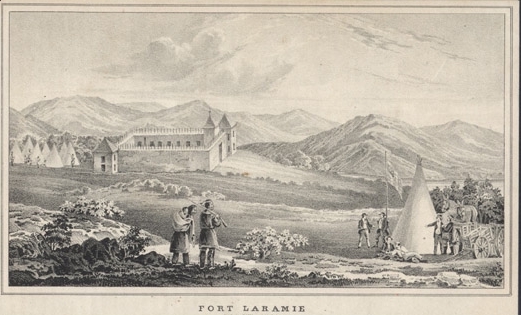
Fort Laramie, 1845 From 1834 until 1890, Ft. Laramie was at the
epicenter of Wyoming history. Adjacent to it were two of the great trails west,
the Emigrant's Road, also known as the Oregon Trail, and the Mormon Trail. To the south ran the
Texas Trail on which cattle were trailed to Wyoming and Montana. The fort was
a stop on the Deadwood Stage Road. From the fort the great expeditions led by both the competent and
the incompetent, both military and
scientific, commenced. Within its precincts were negotiated the great treaties,
honored and dishonored, with the native
Americans.
Ft. Laramie has in its history four incarnations: (a) a cottonwood stockade constructed at Laramie's
Point, but named by Wm. Sublette
"Fort William", 1837 painting by Alfred Jacob Miller below left, interior view by Miller below right; (b)
an adobe fort depicted in the engraving above and at the bottom of the page; (c) a military post; and (d)
finally its present configuration consisting of a mix of restoration to the fort's 1880's appearance and ruins.
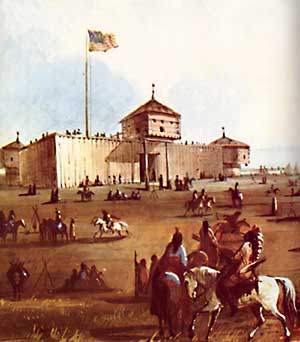 The fort served as a
terminus of the "Trappers' Trail running from Taos northward.
The Trappers Trail fell into disusage when fashions changed and silk replaced beaver in hats.
In 1841,the stockade was replaced by an adobe structure depicted in the engraving above and as
described by Francis Parkman below. While generally
referred to by fort employees as "Fort Laramie," it was named Fort John, after
John Sarpy, a partner in the American Fur Company
and maintained
its importance on the Oregon Trail and Mormon Trail. The fort served as a
terminus of the "Trappers' Trail running from Taos northward.
The Trappers Trail fell into disusage when fashions changed and silk replaced beaver in hats.
In 1841,the stockade was replaced by an adobe structure depicted in the engraving above and as
described by Francis Parkman below. While generally
referred to by fort employees as "Fort Laramie," it was named Fort John, after
John Sarpy, a partner in the American Fur Company
and maintained
its importance on the Oregon Trail and Mormon Trail.
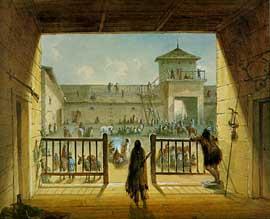 It was also a
terminus for the 300 mile-long Fort Pierre-Fort Laramie Trail. Government freighters
continued to use the trail to Fort Pierre until the 1880's. It was also a
terminus for the 300 mile-long Fort Pierre-Fort Laramie Trail. Government freighters
continued to use the trail to Fort Pierre until the 1880's.
Left and right, 1837 views of Fort William by
Alfred Jacob Miller
Compare with 1850 view at bottom of page. Miller,
a professional artist trained at the Ecole des Beaux Arts in Paris, but originally from
Baltimore, accompanied the Scottish adventurer Captain Sir William Drummond
Stewart on his trip to the 1837 Rendevous discussed with regard to Ft. Bridger.
On the trip Miller not only provided the first
accurate description of a rendevous, but
made a number of pencil sketches, including one of Bridger, featured on the next page,
depicting Bridger, drunk, riding around the rendevous grounds in a replica
suit of armor given to Bridger by Sir William.
Upon his return to the East,
Miller used some of the sketches to make a
number of oil paintings of Nebraska and Wyoming. Additionally,
Miller gave a description of the fort as being:
of a quadrangular form, with block houses at diagonal corners
to sweep the fronts
in case of attack. Over the front entrance is a large blockhouse
in which is placed a cannon. The interior of the fort is about
150 feet square, surrounded by small cabins whose roofs reach
within 3 feet of the top of the palisades against which they abut.
The Indians encamp in great numbers here 3 or 4 times a year,
bringing peltries to be exchanged for dry goods, tobacco, beads
and alcohol. The Indians have a mortal horror of the "big gun"
which rests in the blockhouse, as they have had experience of
its prowess and witnessed the havoc produced by its loud "talk".
They conceive it to be only asleep and have a wholesome dread of
its being waked up.
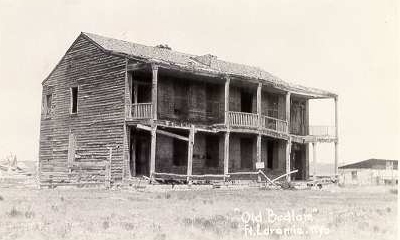 Fort Laramie's "Old Bedlam," prior to restoration.
Fort Laramie's "Old Bedlam," prior to restoration.
Old Bedlam was constructed in 1849 as the bachelor officers quarters ("B.O.Q."). It was also
used for several years as the post headquarters and as a residence for the post
commander. Some have theorized that the name, "Old Bedlam" arose from the
activities of the young officers when the building was used as the B.O.Q., somewhat in the
same manner as some college fraternities have developed an "Animal House"
reputation. Supposedly, some of the
timbers from the original stockade fort were used in its construction.
The remainder of the original fort was recycled as firewood. Old Bedlam is reputedly
the oldest standing building in the state. The building has now been restored, as a part of the national
monument, to its 1854-1855 appearance as depicted in the next photograph.
The restoration was prompted partially due to the efforts of John Hunton, the last
post trader. Stabilization and restoration began in 1938 and was completed in
1964.
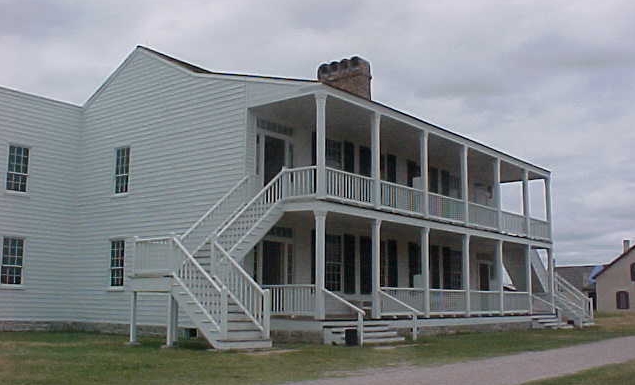
Restored "Old Bedlam," 2001, photo by Geoff Dobson
In 1849, the Fort was sold by the American Fur Company to the military, officially renamed Fort Laramie,
and was rebuilt to the configuaration
now seen as a part of the national monument. The Fort was decommissioned in 1890 and
made a national monument in 1938. Photo of ruins of post hospital below.

Ruins of Post Hospital, Fort Laramie
The adobe fort was described by Francis Parkman, "The Oregon Trail," serialized in
Knickerbocker's Magazine in 21 installments, 1847-48, later published with revisions as
"The California and Oregon Trail,":
"The little fort is built
of bricks dried in the sun, and externally is of an oblong form, with
bastions of clay, in the form of ordinary blockhouses, at two of the
corners. The walls are about fifteen feet high, and surmounted by a slender
palisade. The roofs of the apartments within, which are built close against
the walls, serve the purpose of a banquette. Within, the fort is divided by
a partition; on one side is the square area surrounded by the storerooms,
offices, and apartments of the inmates; on the other is the corral,
a narrow place, encompassed by the high clay walls, where at night, or in
presence of dangerous Indians, the horses and mules of the fort are crowded
for safe-keeping. The main entrance has two gates, with an arched passage
intervening. A little square window, quite high above the ground, opens
laterally from an adjoining chamber into this passage; so that when the
inner gate is closed and barred, a person without may still hold
communication with those within through this narrow aperture. This obviates
the necessity of admitting suspicious Indians, for purposes of trading,
into the body of the fort; for when danger is apprehended, the inner gate
is shut fast, and all traffic is carried on by means of the little window.
This precaution, though highly necessary at some of the company's posts, is
now seldom resorted to at Fort Laramie; where, though men are frequently
killed in its neighborhood, no apprehensions are now entertained of any
general designs of hostility from the Indians."

Sutler's store, Fort Laramie, undated
The Sutler on a military post was a civilian
who had a license to operate a general store on the post. Although prices were
regulated by the government, it remained a highly profitable enterprize. The store at
Fort Laramie was constructed in 1849 and received several additions over the years,
the most recent being an 1883 addition housing the Officers' Club and the enlisted men's
bar. Today in the bar nothing is served stronger than sarsaparilla. But the
bartender is still friendly.
Following the Civil War, the title of sutler was changed to "Post Trader." The
longest serving sutler was Seth Ward (1820-1903), who held the license from 1857 to 1871 not
withstanding that he was a Confederate sympathizer. Indeed, during the Civil War, he vowed
that he would not shave until the South had gained its freedom. At the
time of his death in 1903 he still had a full white beard.
The facility has now been restored to its 1876 appearance.
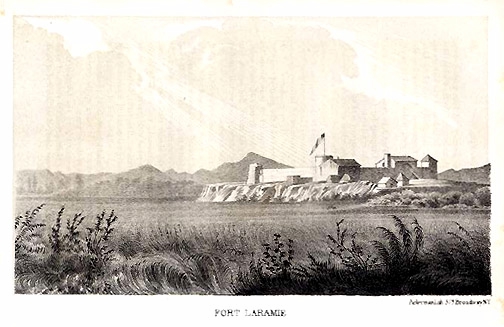
Fort Laramie, 1850. Engraving from Stanbury
Expedition
In 1849-50 Captain Howard Stanbury conducted an expedition to Utah and the Salt Lake. Bridger
acted as a guide. The Expedition discovered a "new" route into Utah. Captain Stanbury's
report was published in 1853.
Ft. Laramie Photos continued on next page.
|